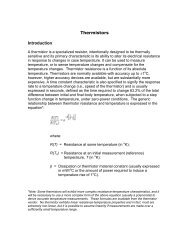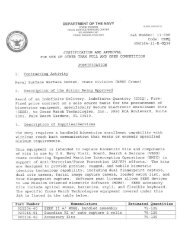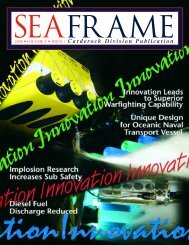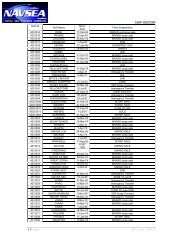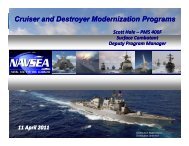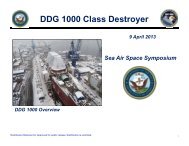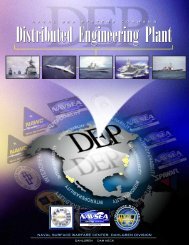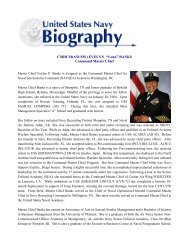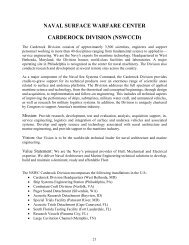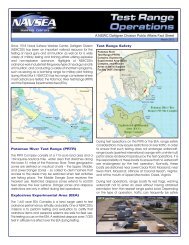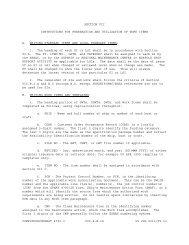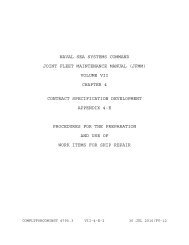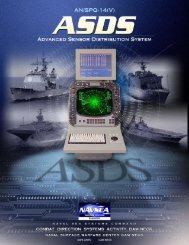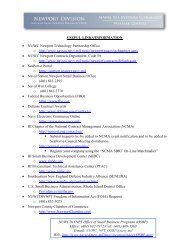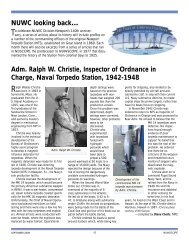Volume 6, Issue 1 - Naval Sea Systems Command - The US Navy
Volume 6, Issue 1 - Naval Sea Systems Command - The US Navy
Volume 6, Issue 1 - Naval Sea Systems Command - The US Navy
Create successful ePaper yourself
Turn your PDF publications into a flip-book with our unique Google optimized e-Paper software.
PILOT PROGRAM<br />
INITIATIVES<br />
B<strong>US</strong>INESS<br />
Supporting the Strategic Business Plan<br />
by Offering Customers Cost Reduction Options<br />
By<br />
Vincent<br />
Wagner<br />
In July 2008, Vice Adm. Kevin<br />
McCoy called upon the Warfare Centers<br />
to support <strong>Naval</strong> <strong>Sea</strong> <strong>Systems</strong> <strong>Command</strong><br />
(NAVSEA) Strategic Business Plan goal<br />
of lowering costs by identifying cost<br />
reduction options for customer approval.<br />
<strong>The</strong> intent was to develop an overall methodology that<br />
would be applicable to most future task statements. <strong>The</strong><br />
vice admiral established two pilot programs relating to<br />
our existing task statements, one of which is the Hull,<br />
Mechanical and Electrical (HM&E) Pilot, under the<br />
direction of Marc Magdinec, Warfare Center Surface<br />
Senior Executive.<br />
NAVSEA’s concern with the current task<br />
statements was that the broad language used by Program<br />
Executive Officer and Program Managers, Directorates, and<br />
the Warfare Centers might not be immediately transparent<br />
in defining the tasks required to achieve the overall program<br />
goal. <strong>The</strong>y also expressed the desire for more clarity<br />
between the technical point of contact and the customer<br />
on specific deliverables. While they recognized the current<br />
approach provides both the program manager and Warfare<br />
Centers needed flexibility during task execution, they<br />
believed that the process could create inefficiencies and<br />
encouraged an unnecessary level of effort. Furthermore,<br />
they were concerned that under the current system<br />
customers had limited ability to assess the risk and impact<br />
of not performing or delaying the execution of work.<br />
<strong>The</strong> initial objective of the pilot program was to<br />
get immediate financial savings that would generate funds<br />
for other navy priorities. Subsequent to the introduction<br />
of the pilot, NAVSEA determined that redirection of these<br />
funds was not a viable option without Congressional level<br />
approval. It was decided that in most cases, the savings<br />
identified would be turned over to the sponsor for reissue to<br />
higher priority tasking. Although the ultimate direction of<br />
the money was changed, it did not alter the initial concept or<br />
the pilot or our approach.<br />
Magdinec, with agreement from the appropriate<br />
sponsor leadership, narrowed our HM&E Pilot down to<br />
SEAFRAME<br />
specific areas, focusing on the DDG 1000 Program and<br />
In-service Ships. To help organize information, we received<br />
support from Program Customer Advocates Bill Merryman,<br />
Joe Amadoro, and Dave Rich. D.J. Benedetti, the Lead<br />
Customer Advocate for Surface, was also involved in the<br />
pilot, responsible for coordinating the SEA 05 efforts that<br />
didn’t fall under Joe or Dave, and helping to coordinate the<br />
overall package. We also received a lot of help from the<br />
Directorates within the Carderock Division.<br />
As the first step of the pilot, Magdinec formed a<br />
team consisting of personnel from SEA 05, SEA 21, and<br />
PEO SHIPS, along with Warfare Center personnel from<br />
Carderock, Dahlgren, and Panama City Divisions. Together,<br />
we reviewed the Task Planning Sheet (TPS), the formal<br />
document used by the sponsors to document tasking. This<br />
review covered the statement of work, funding levels for<br />
both the current and out years, deliverables, key personnel,<br />
signatories, and other information relevant to the customer.<br />
We first examined the documents for clarity and, where<br />
necessary, edited them to assure some standardization.<br />
We also reviewed the facts pertaining to funding, delivery,<br />
monetary amounts, deliverables, milestones and the<br />
POA&M to determine if they were accurate and met<br />
program requirements. For the most part, all information<br />
was satisfactory or simply required minor adjustments. <strong>The</strong><br />
TPSs are a top level document that roles up information<br />
from various meetings, discussions and other documents,<br />
into a single source for all information. When we reviewed<br />
these documents, we all realized that to someone not<br />
intimately familiar with the specific tasks, the documents<br />
could be confusing if all sections were not filled in, so we<br />
made an effort to make sure the TPSs were complete.<br />
This effort certainly made the documents more<br />
standardized and clear to those not regularly involved in the<br />
tasking, but it did not prove to be a tool for significant cost<br />
savings. One significant benefit was it allowed the three<br />
sponsors to review each others TPSs, and they gained an<br />
appreciation for tasking ongoing in the other areas that effect<br />
their tasking.<br />
PILOT PROGRAM INITIATIVES (Continued on page 6)<br />
5



